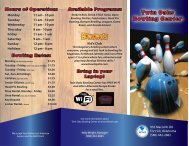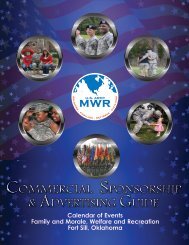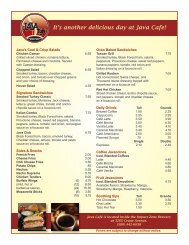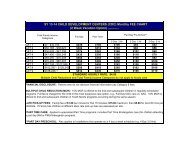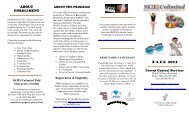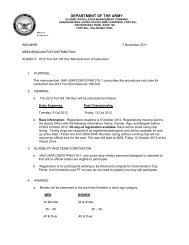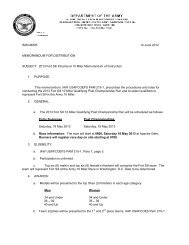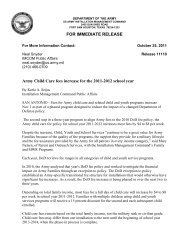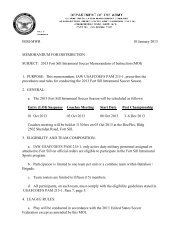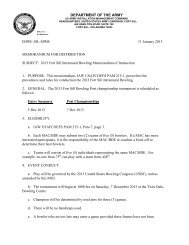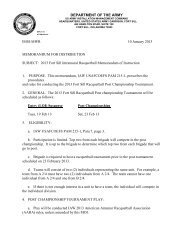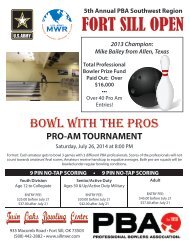Preparing and Managing Correspondence - Fort Sill MWR
Preparing and Managing Correspondence - Fort Sill MWR
Preparing and Managing Correspondence - Fort Sill MWR
Create successful ePaper yourself
Turn your PDF publications into a flip-book with our unique Google optimized e-Paper software.
1–41. NATO correspondence<br />
<strong>Correspondence</strong> for NATO purposes is governed by St<strong>and</strong>ardization Agreements. See guidance in appendix F.<br />
1–42. Recordkeeping requirements<br />
This regulation requires the creation, maintenance, <strong>and</strong> use of the specific record FN 25–50a (Delegation of signature<br />
authority), in accordance with AR 25–400–2.<br />
Section IV<br />
Effective Writing <strong>and</strong> <strong>Correspondence</strong>: The Army Writing Style<br />
1–43. Goal<br />
The goal of all Army correspondence is effective communication.<br />
1–44. St<strong>and</strong>ards for Army writing<br />
a. Effective Army writing transmits a clear message in a single, rapid reading <strong>and</strong> is generally free of errors in<br />
grammar, mechanics, <strong>and</strong> usage.<br />
b. Good Army writing is concise, organized, <strong>and</strong> right to the point. Two essential requirements include putting the<br />
main point at the beginning of the correspondence <strong>and</strong> using the active voice (for example (main point up front), “You<br />
are entitled to jump pay for the time you spent in training last year”).<br />
c. The st<strong>and</strong>ard English sentence order, subject-verb-object, works best. It speeds communication <strong>and</strong> helps the<br />
reader underst<strong>and</strong> the main point.<br />
d. Active writing—<br />
(1) Emphasizes the doer of the action.<br />
(2) Shows who or what does the action in the sentence, or puts the doer before the verb.<br />
(3) Creates shorter sentences. Eliminating the passive voice reduces the number of words in a sentence.<br />
(a) Passive: The PT test was passed by SGT Jones (eight words).<br />
(b) Active: SGT Jones passed the PT test (six words).<br />
e. The passive voice is easy to recognize. A verb in the passive voice uses any form of “to be” plus the past<br />
participle of a main verb (for example, am, is, are, was, were, be, being, been), plus a main verb usually ending in “en”<br />
or “ed” (for example, were completed, is requested).<br />
1–45. Constructing military correspondence<br />
a. General techniques. Focus first on the main point to construct basic military correspondence. Use of the active<br />
voice is the basic style of Army writing.<br />
b. Specific techniques. Meeting the st<strong>and</strong>ards for correspondence requires specific techniques. Use these additional<br />
rules of correspondence construction to improve effectiveness.<br />
(1) Use short words. Try not to use more than 15 percent over two syllables long.<br />
(2) Keep sentences short. The average length of a sentence should be about 15 words.<br />
(3) Write paragraphs that, with few exceptions, are no more than 10 lines.<br />
(4) Avoid jargon.<br />
(5) Use correct spelling, grammar, <strong>and</strong> punctuation.<br />
(6) Use I, you, <strong>and</strong> we as subjects of sentences instead of this office, this headquarters, this comm<strong>and</strong>, all<br />
individuals, <strong>and</strong> so forth.<br />
(7) Write one-page letters <strong>and</strong> memor<strong>and</strong>ums for most correspondence. Use enclosures for additional information.<br />
(8) Avoid sentences that begin with “It is ...,” “There is ...,”or “There are ....”<br />
1–46. Packaging correspondence<br />
a. Structure. The simplified formats in this regulation are specific ways of structuring particular kinds of correspondence.<br />
Packaging, however, applies to all Army writing.<br />
b. Framework. Packaging is the general framework of military writing style. All formats start with this st<strong>and</strong>ard<br />
structure <strong>and</strong> are tailored to each type of correspondence.<br />
c. Packaging. Structure correspondence for easy quick reading:<br />
(1) First, open with a short, clear purpose sentence.<br />
(2) Next, put the recommendation, conclusion, or more important information as the main point. (These first two<br />
steps can be combined in some correspondence.)<br />
(3) Last, clearly separate each section. Use short paragraph headings or section titles.<br />
AR 25–50 • 3 June 2002<br />
7



